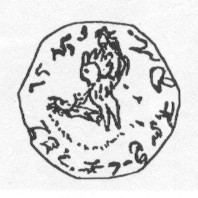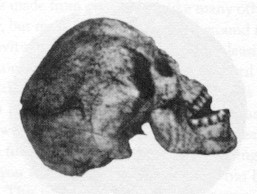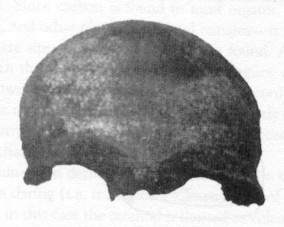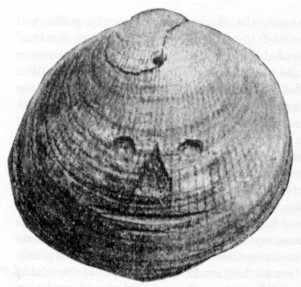The Cenozoic Era is last of the five major eras
of geologic time, beginning about 65 million years ago and
extending through the present. It follows the Cretaceous period
of the Mesozoic era and is subdivided into the Tertiary period
and the Quaternary period. Features of Tertiary times are
considered in articles under the names of the various shorter
time periods (epochs) making up the Tertiary period; in order,
from earliest to latest, these are the Paleocene, Eocene,
Oligocene, Miocene, and Pliocene.
The accepted scientific view of evolution in the Cenozoic Era
shows human beings appearing on the earth about 1.6 million
years ago, and human civilization just 10,000 years ago. Yet the
scientific finds presented below present a very shocking and
different story.
Pleistocene Epoch Finds
 |
Copper Coin from Illinois, over 200,000 years old
This rendition of a coin-like object, from a well boring near Lawn Ridge,
Illinois, was found at a depth of about 114 feet below
the surface. According to the information supplied by
the Illinois State Geological Survey, the deposits
containing the coin are between 200,000 and 400,000
years old... who left this coin hundreds of thousands of
years before civilized man evolved? |
 |
Modern Human Skeleton from Tanzania, over 800,000
years old
In 1913 Professor Hans Reck, of Berlin University,
conducted investigations at Olduvai Gorge in Tanzania,
then German East Africa. During his stay at Olduvai
Gorge, Reck found a modern human skeleton that remains a
source of mystery and controversy to this day. This
modern skull is from a fully human skeleton found that
year. The human skeletal remains, including this
complete skull, were cemented in the rock and had to be
chipped with hammers and chisels. It was found in the
upper end of a rock bed dated at more than 1,000,000
years old. How did this modern human find his way
1,000,000 years into the past? |
|

|
Willendorf Venus Statue, over 30,000 years old
The Willendorf Venus, from Europe, dated at 30,000 years
old. Who created or left this artifact nearly 20,000
years before human civilization appeared? |
 |
Modern Human Skull in Buenos Aires, over 1,000,000
years old
In 1896, workers excavating a dry dock in Buenos Aires
found a modern human skull. The Pre-Ensenadan stratum in
which the Buenos Aires skull was found is a least 1.0 -
1.5 million years old. Even at 1 million years the
presence of a fully modern human skull anywhere in the
world is highly anomalous. Why and how did a modern
human arrive in Buenos Aires over 1,000,000 years ahead
of its time? |
Pliocene Epoch Finds
 |
Figurines from Nampa, Idaho, about 2 million years
old
A small human image, skillfully formed in clay, was
found in 1889 at Nampa, Idaho. The figurine came from
the 300-foot level of a well boring and dated to be
of the Plio-Pleistocene age, about 2 million years old.
G. F. Wright noted, "The image is about an inch and a
half long; and remarkable for the perfection with which
it represents the human form... It was a female figure,
and had the lifelike lineaments in the parts which were
finished that would do credit to the classic centers of
art. Upon showing the object to Professor F. W. Putnam,"
wrote Wright, "he at once directed attention to the
character of the incrustations of iron upon the surface
as indicative of a relic of considerable antiquity.
There were patches of anhydrous red oxide of iron in
protected places upon it, such as could not have been
formed upon any fraudulent object." Humans had not even
evolved on this planet two million years ago. So who
created or left this artifact in earth's distant past? |
 |
Modern Human Skull found in Italy, over 3 - 4
million years old.
Late in the summer of 1860, Professor Giuseppe Ragazzoni,
a geologist and teacher at the Technical Institute of
Brescia, traveled to the nearby locale of Castenedolo,
about 10 kilometers southeast of Brescia, to gather
fossil shells in the Pliocene strata exposed in a pit at
the base of a low hill, the Colle de Vento. Here he
discovered this remarkable and anatomically modern human
skull. The stratum from which it was taken is assigned
to the Astian stage of the Pliocene. According to modern
authorities, the Astian belongs to the Middle Pliocene,
which would give the skull an age of 3 - 4 million
years. Why and how did this modern human visit Italy
nearly two million years before human beings walked the
planet? |
 |
Carved Shell from the Red Crag, England, between 2.0
and 2.5 million years old.
In a report delivered to the British Association for the
Advancement of Science in 1881, H. Stopes, F.G.S.
(Fellow of the Geological Society), described a shell,
the surface of which bore a carving of a crude but
unmistakably human face. The carved shell was found in
the stratified deposits of the Red Crag. The Red Crag,
part of which is called the Walton Crag, is dated to be
of Late Pliocene age between 2.0 and 2.5 million years
old. This find would place intelligent beings in England
as far back as 2.0 million and maybe as much as 2.5
million years ago. One should keep in mind that in terms
of conventional paleoanthropological opinion, one does
not encounter such works of art until the time of fully
modern Cro-Magnon man in the Late Pleistocene, about
30,000 years ago. What visitor to Earth's distant past
carved and left this shell? |
Eocene Epoch Finds
 |
Chalk Ball near Laon, France, 45 - 55 million years
old.
The April 1862 edition of The Geologist included an
English translation of an intriguing report by
Maximilien Melleville, the vice president of the Societe
Academique of Laon , France. This chalk ball was
discovered in an Early Eocene lignite bed. On the basis
of its stratigraphic position, is has been assigned a
date of 45 - 55 million years ago. According to
Melleville, there was no possibility that the chalk ball
was a forgery: "It really is penetrated over four-fifths
of its height by a black bituminous color that merges
toward the top into a yellow circle, and which is
evidently due to the contact of the lignite in which it
had been for so long a time plunged. The upper part,
which was in contact with the shell bed, on the contrary
has preserved its natural color -- the dull white of
the chalk.... As to the rock in which it was found, I
can affirm that it is perfectly virgin, and presents no
trace whatever of any ancient exploitation. As
extraordinary as it might seem to those attached to
standard evolutionary views, the evidence associated in
this find suggest that if humans made the ball, they
must have been in France 45 - 55 million years ago. Who
made and left this man made artifact in our past long
before human evolution... even before grazing and
carnivorous mammals walked the planet? |
 |
Mortar and Pestle in California, up to 55 million
years old.
In 1877 Mr. J. H. Neale was superintendent of the
Montezuma Tunnel Company, and ran the Montezuma tunnel
into the gravel underlying the lava of Table Mountain,
Tuolumne County.... At a distance of between 1400 and
1500 feet from the mouth of the tunnel, or of between
200 and 300 feet beyond the edge of the solid lava, Mr.
Neale saw several spear-heads of some dark rock and
nearly one foot in length. On exploring further, he
himself found a small mortar three or four inches in
diameter and of irregular shape. This was discovered
within a foot or two of the spear-heads. He then found a
large well-formed pestle and near by a large and very
regular mortar. All of these relics were found the same
afternoon, and were all within a few feet of one another
and close to the bed-rock, perhaps within a foot of it.
Mr. Neale declares that it is utterly impossible that
these relics can have reached the position in which they
were found excepting at the time the gravel was
deposited, and before the lava cap formed. The position
of the artifacts in gravel close to the bed-rock at
Tuolumne Table Mountain indicates they were 33-55
million years old. Grazing and carnivorous mammals had
not even evolved on the planet at this time. So who
brought and left behind these artifacts in California
nearly 50 million years ago? |
 |
Sling Stone from Bramford, England, 5 - 50 million
years old.
This sling stone is from the detritus bed beneath the
Red Crag at Bramford, England. At least Pliocene in age,
the stone is at least 5 million and possibly up to 50
million years old. Upon examination it was obvious that
the stone had been shaped by the hand of man.... The
whole surface... has been scraped with a flint, in such
a way that it is covered with a series of facets running
fairly regularly from end to end.... The scraping
described above covers the whole surface of the object,
and penetrates into its irregularities. As it stands the
object is entirely artificial... yet left in a time
millions of years before humans had had even evolved on
the Earth. |
Source: FORBIDDEN
ARCHEOLOGY, The Hidden History of the Human Race, by Michael A.
Cremo and Richard L. Thompson, published by Bhaktivedanta Book
Publishing, Inc. There is no better source for additional
information and study on this subject than Forbidden Archeology.
This remarkable collection of research and analysis is an
important work of thorough-going scholarship and intellectual
adventure.
|
|
|











